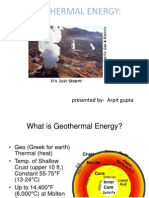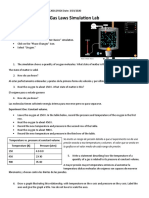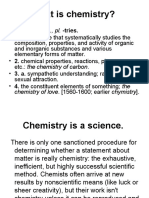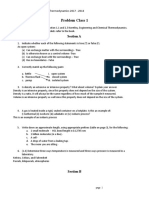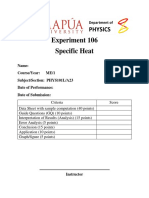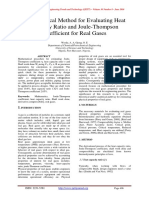First Law of Thermodynamics
First Law of Thermodynamics
Uploaded by
Mariam PittiCopyright:
Available Formats
First Law of Thermodynamics
First Law of Thermodynamics
Uploaded by
Mariam PittiOriginal Description:
Copyright
Available Formats
Share this document
Did you find this document useful?
Is this content inappropriate?
Copyright:
Available Formats
First Law of Thermodynamics
First Law of Thermodynamics
Uploaded by
Mariam PittiCopyright:
Available Formats
Essential UNIVERSITY PHYSICS, Volume 1 Richard Wolfson
18.1 The First Law of Thermodynamics
First Law of Thermodynamics The change in the internal energy of a
system depends only on the net heat transferred to the system and the
net work done by the system, independent of the particular processes
involved.
Mathematically, the first law is
U = Q - W
Change in
Intenal
energy
Heat added
to the
system
Work done
by the
system
18.1 The First Law of Thermodynamics
Example: Heat a gas, it expands against a weight. Force (pressure
times area) is applied over a distance, work is done.
Work done by
the system
Q
Heat added
to the
system
U
U = (U-U)
U = Q - W
Change in internal energy
18.1 The First Law of Thermodynamics
We
are
frequently
concerned
with
rates
of
energy
flow.
Differentiating the first law with respect to time gives a
statement about rates:
dU/dt is the rate of change of a systems internal energy.
dQ/dt is the rate of heat transfer to the system.
dW/dt is the rate at which the system does work.
EXAMPLE 18.1
The First Law of Thermodynamics:
Thermal Pollution
The reactor in a nuclear power plant supplies energy at the rate of
3.0 GW, boiling water to produce steam that turns a turbine-generator.
The spent steam is then condensed through thermal contact with water
taken from a river. If the power plant produces electrical energy at
the rate of 1.0 GW, at what rate is heat transferred to the river?
The entire power plant is our system, comprising the nuclear reactor,
including its fuel, and the turbine-generator.
We identify U as the internal energy stored in the fuel, W as the
mechanical work that ends up as electrical energy, and Q as the heat
transferred to the river.
We know that: dU/dt = dQ/dt dW/dt. The reactor extracts internal
energy from its fuel, so the rate dU/dt is negative; the power plant
delivers electrical energy to the outside world, so dW/dt is positive.
We need to solve for dQ/dt.
EXAMPLE 18.1
The First Law of Thermodynamics:
Thermal Pollution
GIVEN: dU/dt = 3.0GW
and
dW/dt = 1.0 GW
-3.0 GW
1.0 GW
-3.0 GW + 1.0 GW
-2.0 GW
18.2 Thermodynamic Processes
Although the 1st law applies to any system, its easiest to understand
when applied to an ideal gas. The ideal gas law relates the
temperature, pressure, and volume of a given gas sample:
pV = nRt
The thermodynamic state is completely determined by any two of this
quantities p, V, or T.
p,V,T
p
p,V,T
V
18.2 Thermodynamic Processes
Reversible and Irreversible Processes
If we raise the
reservoir
temperature very
slowly, both the
water and gas
temperatures will
rise in unison,
and the gas will
remain in
equilibrium.
These temperatures stay the same as
the water temperature increases
slowly
Water
Gas
Temperature control
Quasi-static
process
A system is always
in thermodynamic
equilibrium.
18.2 Thermodynamic Processes
Reversible and Irreversible Processes
Reversible Process:
We could reverse
this heating
process by slowly
lowering the
reservoir
temperatur; the gas
would cool,
reversing its path
in the pV diagram.
These temperatures stay the same as
the water temperature increases
slowly
Water
Gas
Temperature control
Irreversible
Process:
If we suddenly
plunging a cool gas
sample into hot
water, then it
becomes and
irreversible
process.
The system is not
in equilibrium.
18.2 Thermodynamic Processes
Work and Volume Changes
The work done by the system is related to the changes in
pressure and volume:
(work done during volume change)
18.2 Thermodynamic Processes
Isothermal Processes
An isothermal process occurs at constant temperature.
To find work, we relate pressure and volume through the ideal gas law:
p = (nRT)/V. Then it becomes:
For an isothermal process, the temperature T is constant, giving
18.2 Thermodynamic Processes
Isothermal Processes
The first law of thermodynamics then gives U = 0 = Q W, so
T = constant
Q = W
W = nRT*ln(V/V)
pV = constant
18.2 Thermodynamic Processes
Constant-Volume Processes and Specific Heat
A constant-volume process occurs in a rigid closed container whose
volume cant change.
To express U = Q in terms of a temperature change T, we introduce
the molar specific heat at constant volume Cv defined by:
V = constant
Q = U
W = 0
Q = nCvT
V
18.2 Thermodynamic Processes
Isobaric Processes and Specific Heat
Isobaric means constant pressure. Processes occurring in systems
exposed to the atmosphere are essentially isoberic. The work done as
the volume changes from V to V, is the area under the isobar, or
W = p(V-V) = pV
(isobaric process)
Cp is the molar specific heat at constant pressure.
(molar specific heats)
18.2 Thermodynamic Processes
Isobaric Processes and Specific Heat
isobar
T
T
W
V
p = constant
Q = U + W
W = p(V-V)
Q = nCpT
Cp = Cv + R
18.2 Thermodynamic Processes
Adiabatic Processes
In an adiabatic process, no heat flows between a system and its
environment. The way to achieve this is to surround the system with
perfect thermal insulation.
Since the heat Q is zero in an adiabatic process, the 1st law becomes
simply
U = -W
(adiabatic process)
18.2 Thermodynamic Processes
Adiabatic Processes
As a gas expands adiabatically, its volume increases while its
internal energy and temperature decrease. The ideal-gas law,
pV=nRT, then requires that the pressure decrease as well and by
more than it would in an isothermal process where T remains
constant.
(adiabatic process)
18.2 Thermodynamic Processes
Adiabatic Processes
Q = 0
U = -W
W = (pV-pV)/(-1)
pV = constant
TV(-1) = constant
EXAMPLE 18.3
An Adiabatic Process: Diesel Power
Fuel ignites in a diesel engine from the heat of compression as the
piston moves toward the top of the cylinder; theres no spark plug as
in a gasoline engine. Compression is fast enough that the process is
essentially adiabatic. If the ignition temperature is 500C, WHAT
COMPRESSION RATIO Vmax/Vmin is needed? Airs specific-heat ratio is
=1.4, and before compression the air is at 20C.
The problem involves temperature and volume, we apply the formula
TminVmin(-1) = TmaxVmax(-1).
Solving for the compression ratio Vmax/Vmin gives
18.3 Specific Heats of an Ideal Gas
The specific heats of an ideal gas follow from the degrees of
freedom of each molecule:
Monatomic
Diatomic
3 degrees of freedom
5 degrees of freedom
Cv = (3/2)R
Cv = (5/2)R
You might also like
- Tensor Analysis For Engineers and Physicists, Schobeiri, Springer, 2021Document252 pagesTensor Analysis For Engineers and Physicists, Schobeiri, Springer, 2021dsanzjulianNo ratings yet
- Solutions - Callen H.B. - Exercicios Resolvidos (Cap (01-06) )Document61 pagesSolutions - Callen H.B. - Exercicios Resolvidos (Cap (01-06) )Leonardo Xavier Neves79% (14)
- 01 Data Handling & MeasurementDocument17 pages01 Data Handling & Measurementjgd2080No ratings yet
- Chapter 04 Humidity Condensation and CloudsDocument13 pagesChapter 04 Humidity Condensation and CloudsnaveedNo ratings yet
- 10 FluidDynamicsDocument39 pages10 FluidDynamicsSyed Raheel AdeelNo ratings yet
- Geothermal EnergyDocument19 pagesGeothermal EnergyKanika AgarwalNo ratings yet
- Protein SynthesisDocument2 pagesProtein SynthesisAbigailNo ratings yet
- MICROBIOLOGYDocument10 pagesMICROBIOLOGYTUYA JOHNVICNo ratings yet
- MOLINA Lesson 4 Post Assessment PHYS 216ADocument4 pagesMOLINA Lesson 4 Post Assessment PHYS 216AZylle Pearl Castillo JerezNo ratings yet
- HeatDocument63 pagesHeatShinjiNo ratings yet
- Activity Boyle's LawDocument1 pageActivity Boyle's LawmikaNo ratings yet
- Thermodynamics FinalDocument17 pagesThermodynamics FinalkingabrahampalecpecNo ratings yet
- 19.air Pressure and WindDocument35 pages19.air Pressure and WindJohn Mervic SumenaNo ratings yet
- Internal Energy of An Ideal GasDocument3 pagesInternal Energy of An Ideal GasSelvakumar JanakiramanNo ratings yet
- We Are Not Rich by What We Possess But by We Can Do Without"Document2 pagesWe Are Not Rich by What We Possess But by We Can Do Without"RonibeMalinginNo ratings yet
- Activity 12 Enzyme ActivityDocument4 pagesActivity 12 Enzyme ActivityEllen May Diaz-ToringNo ratings yet
- Phys 3 - Syllabus - 2ndsem2016-2017Document6 pagesPhys 3 - Syllabus - 2ndsem2016-2017Aida Campos100% (1)
- Gas Laws Simulation Lab: Experiment One: Constant VolumeDocument4 pagesGas Laws Simulation Lab: Experiment One: Constant Volumealan musselwhite100% (1)
- Difference Between Cold-Blooded and Warm-Blooded AnimalsDocument5 pagesDifference Between Cold-Blooded and Warm-Blooded AnimalsShakil AhmedNo ratings yet
- Heat Transfer 2Document24 pagesHeat Transfer 2AshMere MontesinesNo ratings yet
- Chapter 2 Mass - Volume.density - Notes PDFDocument17 pagesChapter 2 Mass - Volume.density - Notes PDFJohn JensenNo ratings yet
- What Is Reinforcement LearningDocument12 pagesWhat Is Reinforcement LearningranamzeeshanNo ratings yet
- What Is The Difference Between Classical and Modern PhysicsDocument2 pagesWhat Is The Difference Between Classical and Modern PhysicsScribdTranslations100% (1)
- ROOTS ReviewerDocument5 pagesROOTS ReviewerMANALANG JULIA ALEXISNo ratings yet
- Thermodynamics Final 2016 SolutionDocument21 pagesThermodynamics Final 2016 Solutionbobbyy222100% (1)
- Five e Lesson Plan - Egg OsmosisDocument3 pagesFive e Lesson Plan - Egg Osmosisapi-336264987100% (1)
- Marriage and Family Relationship - 092618Document27 pagesMarriage and Family Relationship - 092618Rich Chelle Relente100% (1)
- Physics For Engineers Tah Module PDFDocument15 pagesPhysics For Engineers Tah Module PDFFRANCES VISAYANo ratings yet
- Human BehaviorDocument6 pagesHuman BehaviorsurjitxinghaNo ratings yet
- Experiment No. 2 Forms and Changes in Energy - Mobo&batitisDocument4 pagesExperiment No. 2 Forms and Changes in Energy - Mobo&batitisChristine MNo ratings yet
- Nervous SystemDocument44 pagesNervous SystemAshraf SidrahNo ratings yet
- Module 2: Theory of Relativity: OverviewDocument19 pagesModule 2: Theory of Relativity: OverviewKay LagunaNo ratings yet
- Partner Learning and Deductive MethodDocument17 pagesPartner Learning and Deductive MethodMha RizNo ratings yet
- Instant download Managing Human Behavior in Public and Nonprofit Organizations 5th Edition Denhardt Test Bank pdf all chapterDocument32 pagesInstant download Managing Human Behavior in Public and Nonprofit Organizations 5th Edition Denhardt Test Bank pdf all chapterruthramoggas100% (7)
- Lecture Outlines Powerpoint: Earth Science, 12EDocument36 pagesLecture Outlines Powerpoint: Earth Science, 12EYen AduanaNo ratings yet
- Balanced and Unbalanced ForcesDocument31 pagesBalanced and Unbalanced ForcesInah MasubayNo ratings yet
- Internal Energy, Heat and Work WorksheetsDocument2 pagesInternal Energy, Heat and Work WorksheetsJayko TanNo ratings yet
- 50 Ways of Promoting PeaceDocument8 pages50 Ways of Promoting PeaceCHOFOR VITALISNo ratings yet
- CHAPTER I-Introduction To Nanoscience and NanotechnologyDocument27 pagesCHAPTER I-Introduction To Nanoscience and NanotechnologyMobeen MurtazaNo ratings yet
- Energy ProblemsDocument2 pagesEnergy ProblemsJorge RodríguezNo ratings yet
- Pec 103Document12 pagesPec 103Rainiel Victor M. CrisologoNo ratings yet
- Experiment 104 Indiv ReportDocument4 pagesExperiment 104 Indiv ReportReine Amabel JarudaNo ratings yet
- Module9. The Information Age.2Document14 pagesModule9. The Information Age.2Krish TineNo ratings yet
- Activity On Standing Wave Motion For Laboratory (Bautista)Document4 pagesActivity On Standing Wave Motion For Laboratory (Bautista)Dan Patrick BautistaNo ratings yet
- Final Report 5Document5 pagesFinal Report 5Alyssa OrtegaNo ratings yet
- Bunsen Burner and Flame Experiment Lesson Plan #4Document3 pagesBunsen Burner and Flame Experiment Lesson Plan #4ericadarmand100% (2)
- Stage 2 - Assessment EvidenceDocument2 pagesStage 2 - Assessment Evidenceapi-506042795No ratings yet
- Understanding The World Wide WebDocument8 pagesUnderstanding The World Wide WebHarshita Chaturvedi100% (1)
- Is Reading A Wonderful Human Activity?: Chrizza May Sabarre Meth5 Mrs. BradyDocument3 pagesIs Reading A Wonderful Human Activity?: Chrizza May Sabarre Meth5 Mrs. BradyLulu BritanniaNo ratings yet
- General Physics 2: Rochelle R. Callo, LPTDocument11 pagesGeneral Physics 2: Rochelle R. Callo, LPTMathchelle CalloNo ratings yet
- Atomic TheoryDocument42 pagesAtomic TheoryMarvin RoselNo ratings yet
- Lab ElectricfieldandpotentialDocument3 pagesLab Electricfieldandpotentialjose taco100% (1)
- Unit PlanDocument42 pagesUnit Planapi-484319209No ratings yet
- PHY 105 Part 1 - Introductory Waves and OpticsDocument221 pagesPHY 105 Part 1 - Introductory Waves and OpticsBishopNo ratings yet
- STM 006 Reviewer For First Periodical ExamDocument4 pagesSTM 006 Reviewer For First Periodical Examsierra.johnfrancis123No ratings yet
- 5e Lesson - Dagne Beza-Protein SynthesisDocument5 pages5e Lesson - Dagne Beza-Protein Synthesisapi-528044846No ratings yet
- Ideal Gas Law LabDocument12 pagesIdeal Gas Law LabAudric Zuriel CruzNo ratings yet
- What Is Chemistry?: Chemistry of Love. (1560-1600 Earlier Chymistry)Document8 pagesWhat Is Chemistry?: Chemistry of Love. (1560-1600 Earlier Chymistry)asepNo ratings yet
- What Is A NetworkDocument9 pagesWhat Is A NetworkDannisIslan AlternateNo ratings yet
- Gestalt PrinciplesDocument16 pagesGestalt PrinciplesRodilyn GuindulmanNo ratings yet
- First Law of ThermodynamicsDocument21 pagesFirst Law of ThermodynamicsMariam50% (2)
- W PDV: Heat and Work in Thermodynamic ProcessesDocument1 pageW PDV: Heat and Work in Thermodynamic ProcessesJemar LimNo ratings yet
- Linearization Assignment W-Solution SaDocument7 pagesLinearization Assignment W-Solution SaFikri Al Ayubi0% (1)
- Thermodynamics Problem Set 1Document4 pagesThermodynamics Problem Set 1fadum099No ratings yet
- Instant Download The Dirac Equation in Curved Spacetime A Guide For Calculations Peter Collas PDF All ChapterDocument54 pagesInstant Download The Dirac Equation in Curved Spacetime A Guide For Calculations Peter Collas PDF All Chaptermoofizxaw100% (8)
- Experiment 106 Specific Heat: PhysicsDocument4 pagesExperiment 106 Specific Heat: PhysicsJag MasterNo ratings yet
- ENGR 233 Lecture 24 FinalDocument22 pagesENGR 233 Lecture 24 FinalZiad JreijNo ratings yet
- Electro Magentism Itnereferation in The Metropolita AreaDocument8 pagesElectro Magentism Itnereferation in The Metropolita AreaAndreescu CristianNo ratings yet
- s2 1 PDFDocument3 pagess2 1 PDFkrishnaNo ratings yet
- Abraham A. Ungar - On The Origin of The Dark Matter/Energy in The Universe and The Pioneer AnomalyDocument6 pagesAbraham A. Ungar - On The Origin of The Dark Matter/Energy in The Universe and The Pioneer AnomalyUmav24No ratings yet
- 10080-A First Book of Quantum Field Theory-Amitabha LahiriDocument393 pages10080-A First Book of Quantum Field Theory-Amitabha LahiriruserzzzNo ratings yet
- Thermodynamics NEET PYQ SOLUTIONDocument18 pagesThermodynamics NEET PYQ SOLUTIONsomeone noone100% (2)
- Instant download Hodge Theory 1st Edition Eduardo Cattani pdf all chapterDocument61 pagesInstant download Hodge Theory 1st Edition Eduardo Cattani pdf all chapternatiancelery100% (3)
- The Guided Moments Formalism: A New Efficient Full-Neutrino Treatment For Astrophysical SimulationsDocument20 pagesThe Guided Moments Formalism: A New Efficient Full-Neutrino Treatment For Astrophysical Simulationsjosealbertoramirezespana0No ratings yet
- HeyhhuDocument10 pagesHeyhhuAbhijeet JhankalNo ratings yet
- Lab08 09Document4 pagesLab08 09tenk8595No ratings yet
- Subject: - CET Semester: - CH4I Topic-III: - Thermodynamic QuantitiesDocument40 pagesSubject: - CET Semester: - CH4I Topic-III: - Thermodynamic QuantitiesPrajwal KaleNo ratings yet
- Applied Thermodynamics Question BankDocument6 pagesApplied Thermodynamics Question BankHema3110100% (1)
- Thermal Properties of Matter Class 11 Notes Physics Chapter 11Document9 pagesThermal Properties of Matter Class 11 Notes Physics Chapter 11Khirod Chandra BarikNo ratings yet
- Chapter 5 - Magnetic SystemsDocument40 pagesChapter 5 - Magnetic SystemsErick Natividad ZevallosNo ratings yet
- CO1-I-1 (Part - 1)Document46 pagesCO1-I-1 (Part - 1)Sivateja Nallamothu100% (1)
- gstomDocument396 pagesgstomLuis Martin EchenikeNo ratings yet
- Assignment No. 3Document1 pageAssignment No. 3kedarkhot10officialNo ratings yet
- 1 s2.0 S0010482522003985 MainDocument12 pages1 s2.0 S0010482522003985 Mainahmed.mohammedNo ratings yet
- Euler Equation Fluid Dynamics PDFDocument2 pagesEuler Equation Fluid Dynamics PDFDianaNo ratings yet
- A New Formulation of Quantum Mechanics: A. I. Arbab, Faisal A. YasseinDocument7 pagesA New Formulation of Quantum Mechanics: A. I. Arbab, Faisal A. YasseinprabhamathsNo ratings yet
- Winitzki - Heidelberg Lectures On Quantum Field Theory in Curved SpacetimeDocument59 pagesWinitzki - Heidelberg Lectures On Quantum Field Theory in Curved SpacetimewinitzkiNo ratings yet
- BTGT2 MI1026 Ver2024Document17 pagesBTGT2 MI1026 Ver2024Gia BảooNo ratings yet
- Cos PerDocument137 pagesCos PerTheja srinivasNo ratings yet
- Black Holes and Holography Course NotesDocument71 pagesBlack Holes and Holography Course NotesLeonardoSanhuezaMardonesNo ratings yet





